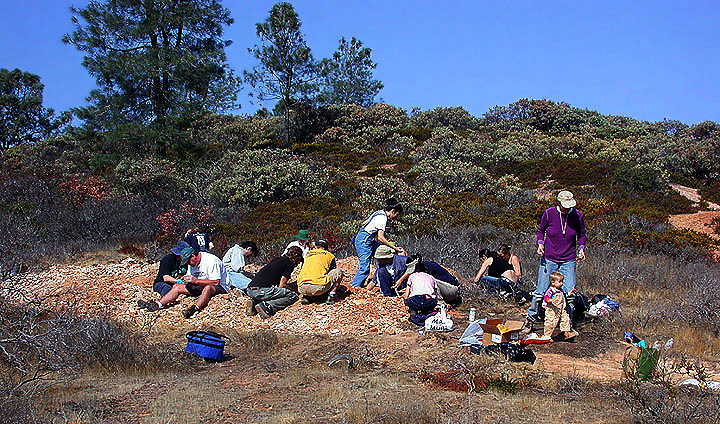
|
Students from a Community College and a university help collect fossil leaves from the Middle Eocene Ione Formation at famous Lygodium Gulch during a weekend field trip to the Ione Basin, western foothills of the Sierra Nevada, Amador County, California. The combined student forces helped increase the numbers of fossil leaves available for a fascinating paleobotanical project sponsored by the National Science Foundation--to study the Eocene floras of the Sierra Nevada district, in order to determine the paleoelevations and paleoclimate of the ancestral Eocene Sierra Nevada. Image taken on October 27, 2002. In early October, 2002, I received a most-interesting email from paleobotanist Howard Schorn (retired Collections Manager Of Fossil Plants at the University California Museum Of Paleontology in Berkeley). A couple of professors he knew--one from a Community College, the other from a university--had contacted him regarding a possible field trip to the classic Lygodium Gulch fossil leaf-bearing site in the Middle Eocene Ione Formation, Ione Basin, western foothills of the Sierra Nevada, Amador County, California. Ordinarily, the professors would have taken their students to a well-known, productive plant fossil site in western Nevada; but...the Autumn weather had turned way too cold, way too windy and unpredictable in the Great Basin. The professors were looking for a viable paleobotanical alternative to the Nevada locality. Originally, they had contacted paleobotanist Dr. Diane Erwin, present Collections Manager Of Fossil Plants at the University California Museum Of Paleontology, who immediately suggested that Lygodium Gulch in the Ione Basin of California might make a fine substitute. Dr. Erwin knew that much more fossil leaf material needed to be gathered from the Middle Eocene Ione Formation; combining forces with the professors and their students seemed like a most-happy and propitious arrangement. The students could fulfill their respective course obligations while at the same time helping the Museum Of Paleontology amass additional fossil leaf specimens from one of the most significant fossil leaf localities in all of California. Dr. Erwin had then contacted Howard Schorn, who in turn emailed me with the field trip proposal. Howard and I agreed that this was a terrific opportunity to collect in a rather efficient manner, and in a concentrated period of time, many more fossil leaf specimens from the Ione Formation--all in preparation for the final installment of a project sponsored by the National Science Foundation, when paleobotanist Dr. Jack A. Wolfe would use his world-famous CLAMP analysis (Climate Leaf Analysis Multivariate Program), to help determine the paleotemperatures and paleoelevations of the ancestral Sierra Nevada. CLAMP is an accurate paleobotanical methodology in which the overall size, shape, venation and leaf margins of fossil leaves are analyzed to arrive at the paleoelevation and paleoclimate of a given fossil flora during the geologic past. In preparation for the planned field trip over the weekend of October 25-27, 2002, Howard graciously reserved rooms for the both of us at a motel in Jackson, the County Seat of Amador County, California The students and their professors planned to camp out for the weekend at a nearby park. Also, in a series of emails regarding the "plan of attack" at Lygodium Gulch, Howard and I arrived at the same inescapable conclusion--before the professors and their students could work the quarry with fossil-finding efficiency, we would need to expand the fossil trench there considerably. This meant hiring, once again, a backhoe operator to rip open the strata there, exposing on the dumps additional huge blocks of fossiliferous shales for the fossil crews to split apart, revealing to their first light of day in some 45 million years the many beautiful fossil leaves hiding in the rocks. During our first expedition to the Ione Basin and Lygodium Gulch in late July-early August, 2002, Howard had first hired a backhoe operator to entrench the leaf-bearing horizon. This time around, he planned to do the very same thing. It just made sense to the both of us. Please note: All fossil localities in the Ione Formation of Amador County, California, presently occur on private property; explicit permission from the land owners must be secured before collecting fossils there. |